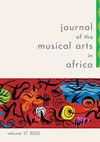‘Before and after … ’: two eras of ethnomusicology. Interview with Simha Arom
IF 0.2
4区 艺术学
0 MUSIC
引用次数: 0
Abstract
History shows us that almost all great musicians were born and raised in permanent contact with music within the confines of their own family. Simha Arom’s childhood experience was that of accompanying his father, an amateur cantor, in the singing of Jewish liturgical chants, and this influenced his entire musical career. In particular, it aroused his curiosity about music that does not have any explicit theory, like the music found in African traditions. As he explains in the documentary Simha (2015),1 he and his brother used to sing the drone while their father sang the melody and through gentle nudges indicated when they had to change pitch. This is how they learnt, empirically, as is the case with the traditions just mentioned. After the ‘Kristallnacht’ pogrom in November 1938, Arom was forced to flee across Europe, a journey that profoundly affected his musical development. While crossing the Pyrenees into Spain on foot in 1944 en route to Palestine – then still under British mandate – he met a violinist called ‘Henry Violin’. It was so ‘miraculous’ listening to him play that it made Simha want to become a musician himself. Initially he was placed in a children’s village in Palestine, but soon managed to transfer to another such village, where he could study the violin. To do so, however, he first had to stage a ‘mild’ hunger strike and then had to work as a mason so that he had enough money to hire a violin in Tel Aviv and continue his studies. He was wounded in the right arm during military service in Israel’s War of Independence (1948), which put paid to his career as a violinist. But not his career as a musician, for he decided to change to the French horn, for which one mainly really needs the left hand... As Arom rather jokingly put it, this gave him more opportunities in Israel, where violinists were ten a penny but horn players rare. He began studying in Jerusalem, later pursuing his studies at the French National Conservatoire in Paris where“之前和之后”:民族音乐学的两个时代。采访Simha Arom
历史告诉我们,几乎所有伟大的音乐家都是在自己的家庭环境中出生和成长,一直与音乐接触。Simha Arom的童年经历是陪伴他的父亲,一个业余的合唱团,在唱犹太礼拜圣歌,这影响了他的整个音乐生涯。特别是,它引起了他对没有任何明确理论的音乐的好奇心,比如非洲传统音乐。正如他在纪录片《Simha》(2015)中解释的那样,他和他的兄弟过去常常在父亲唱旋律的时候唱无人机,当他们必须改变音高时,他们会轻轻地推一下。这就是他们从经验中学习的方式,就像刚才提到的传统一样。在1938年11月的“水晶之夜”大屠杀之后,阿隆被迫逃离欧洲,这段旅程深刻地影响了他的音乐发展。1944年,他徒步穿越比利牛斯山脉进入西班牙,前往当时仍在英国统治下的巴勒斯坦,途中遇到了一位名叫“亨利·拉琴”的小提琴家。听他演奏是如此“神奇”,以至于西姆哈自己也想成为一名音乐家。最初,他被安置在巴勒斯坦的一个儿童村,但很快就设法转移到另一个这样的村庄,在那里他可以学习小提琴。然而,为了做到这一点,他首先不得不进行“温和”的绝食抗议,然后不得不做一名泥瓦匠,这样他就有足够的钱在特拉维夫雇一把小提琴,继续他的学业。他在以色列独立战争(1948年)服兵役期间右臂受伤,从此结束了他的小提琴生涯。但这并不是他的音乐家生涯,因为他决定改吹法国号,而这种乐器主要需要左手来演奏……正如亚罗姆开玩笑说的那样,这给了他在以色列更多的机会,在那里小提琴手很少见,而圆号手却很少。他开始在耶路撒冷学习,后来在巴黎的法国国家音乐学院学习
本文章由计算机程序翻译,如有差异,请以英文原文为准。
求助全文
约1分钟内获得全文
求助全文

 求助内容:
求助内容: 应助结果提醒方式:
应助结果提醒方式:


